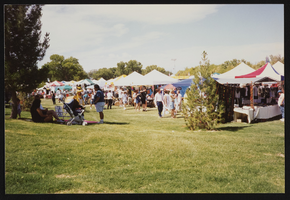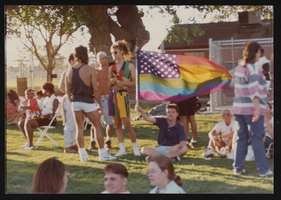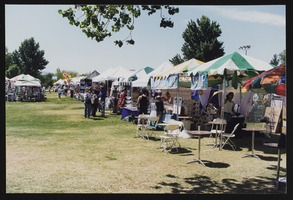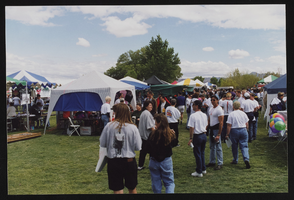Search the Special Collections and Archives Portal
Search Results

Booths and people at Sunset Park for Gay Pride, image 006: photographic print
Date
Archival Collection
Description
Gay Pride 1997 (Dennis McBride, photographer) Sunset Park. (5-10-97)
Image
Count Guido Roberto Deiro oral history interview
Identifier
Abstract
Oral history interview with Count Guido Roberto Deiro conducted by David G. Schwartz on January 30, 2002 and November 22, 2017 for the Boyer Early Las Vegas Oral History Project. Deiro gives his personal recollections of living in Las Vegas, Nevada, including his father’s career, his upbringing, and fondest memories of the city.
Archival Collection
Dr. Ed Goldman oral history interview
Identifier
Abstract
Oral history interview with Dr. Edward Goldman conducted by Barbara Tabach on March 22, 2016 and April 04, 2016 for the Southern Nevada Jewish Heritage Project. Goldman discusses his career as a Clark County School District teacher, negotiator, and regional superintendent over the span of thirty years. He also talks about his activity in the Las Vegas, Nevada Jewish community at Temple Beth Sholom and being a founding member of Midbar Kodesh Temple.
Archival Collection

Las Vegas Gay Pride Festival in Las Vegas, Nevada: photographic prints
Date
Archival Collection
Description
From the Las Vegas Bugle Photograph Collection on Lesbian, Gay, Bisexual, and Transgender History (PH-00336). Las Vegas Gay Pride Festival - June 5, 1994.
Image

Interview with Gay (Gertrud Anne Yoder) Kauffman, October 11, 2006
Date
Archival Collection
Description
Access note: Audio temporarily sealed
Text

Booths and people at Sunset Park for Gay Pride, image 011: photographic print
Date
Archival Collection
Description
Gay Pride at Sunset Park (5-8-99) Photographer: Dennis McBride
Image

Booths and people at Sunset Park for Gay Pride, image 012: photographic print
Date
Archival Collection
Description
Gay Pride at Sunset Park (5-8-99) Photographer: Dennis McBride
Image

Booths and people at Sunset Park for Gay Pride, image 008: photographic print
Date
Archival Collection
Description
Gay Pride 1998 at Sunset Park. Photographer: Dennis McBride.
Image
Mirta G. Feinberg oral history interview
Identifier
Abstract
Oral history interview with Mirta G. Feinberg conducted by Jeffrey Smith on April 22, 2006 for the Public School Principalship Oral History Project. In this interview, Feinberg reflects upon her 38-year career in education, with the bulk of her career taking place in California. She describes the process by which she became a principal, and her experiences working with bilingual education. She discusses challenges that she faced as a principal such as school safety, and describes her working relationship as a principal with assistant principals.
Archival Collection
Leah Chan Grinvald oral history interview
Identifier
Abstract
Oral history interview with Leah Chan Grinvald conducted by Stefani Evans and Claytee D. White on January 22, 2024 for the Reflections: the Las Vegas Asian American and Pacific Islander Oral History Project. In this interview, Grinvald discusses growing up with a large Chinese family on her father's side, and an Orthodox Jewish family on her mother's side. Grinvald talks about family, identity, traditions, and schooling. She discusses how she became interested in law, her legal career, and volunteer work with the affinity Bars in Nevada, the State Bar of Nevada Board of Bar Governors, and the Association of American Law Schools Deans Council Executive Committee. She also talks about meeting her Israeli husband, marrying him in Israel, and living there for a year.
Archival Collection
